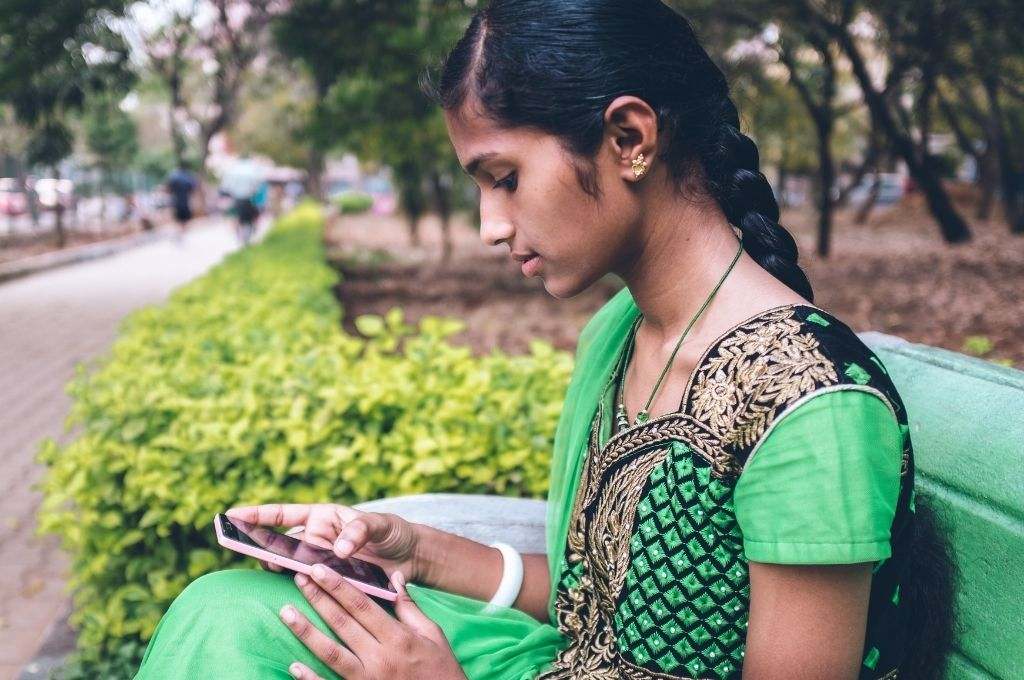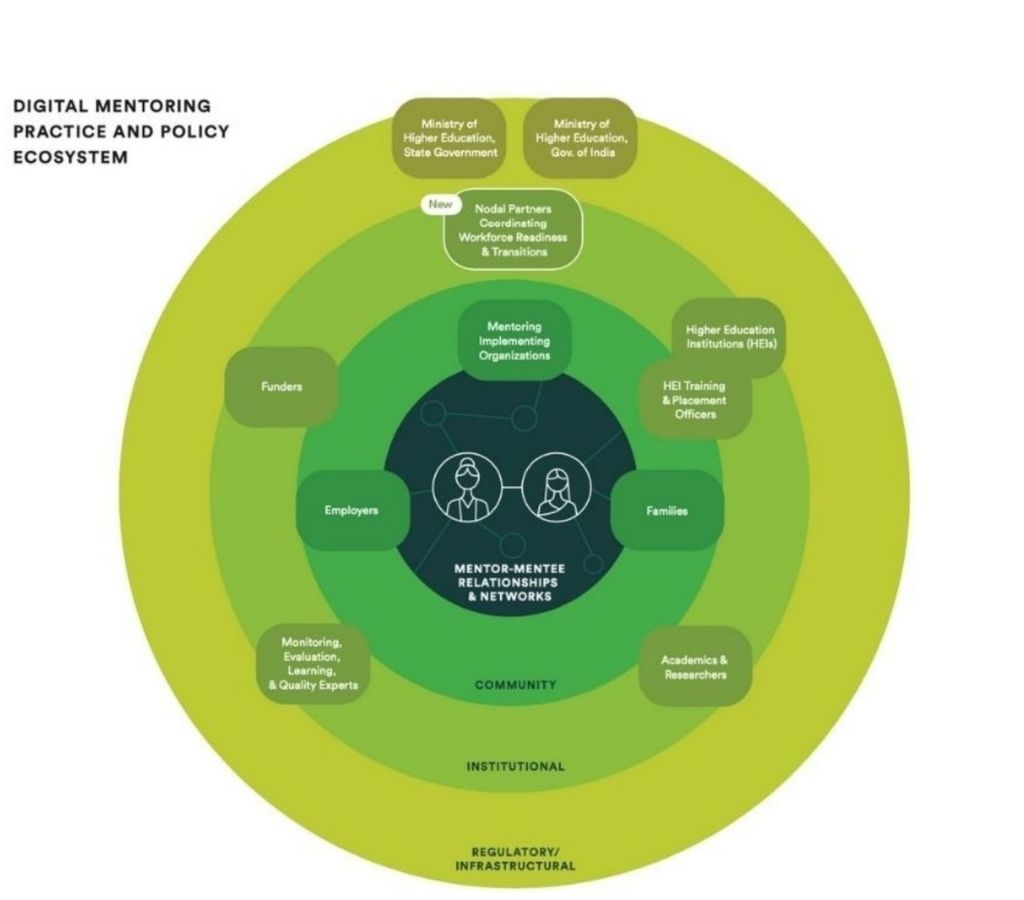Today, approximately 19 million young women are accessing post-secondary or tertiary education in India. Yet, such education has not translated into expected gains in female labour force participation. Only 34 percent of women in India with post-secondary education are active in the labour force, compared to 81 percent of men.
Gender equality in the labour force is more than an economic end in itself; it is also a significant way to empower women. Women who work in India have more say in household decision-making and can delay their age of marriage and the birth of their first child.
The relatively low number of women in the workforce includes both women who are employed and those actively searching for jobs. Therefore, I examined the impact of three interlinked factors that uniquely constrain young women’s capabilities or choices to participate in the workforce: a skills deficit, a network gap, and restrictive gender norms.

- Skills deficit: Post-secondary curricula rarely address eight of the ten skills employers currently value most, which relate to problem-solving, self-management, and working with people, and they are seldom built through traditional instructional approaches in classrooms.
- Network gap: Women in India tend to have small professional networks because social norms restrict them from engaging freely. A small network means a lack of role models, which limits aspirations and reduces the likelihood of women breaking gender stereotypes and pursuing career paths where they do not see other women. It can also mean access to fewer job-market opportunities at the time of planning for entry into the labour market.
- Restrictive gender norms: Indian social norms define a woman’s role as primarily that of a caregiver, and thus discourages female labour force participation. In urban areas, women’s participation in the labour force drops off in their early- to mid-twenties—when marriage- and family-related responsibilities tend to increase.
In conceptualising the role that mentorship can play to tackle these three challenges, I reviewed more recent research that model mentoring programmes as a context for activities, and not just as a set of one-to-one relationships. The latter has been the predominant format in which mentoring programmes have emerged across the globe as an effective positive youth development practice. Viewing mentorship as a context for activities recognises the many systems surrounding a young person that also need active shaping or reshaping. As in this case of female labour force participation, focusing solely on young women’s skills is necessary but insufficient. If we do not increase the opportunities she has access to or the support her family provides her, we cannot meaningfully change her life outcomes.

A newer format of mentoring—digital mentoring—holds promise in tackling all three of these factors collectively. Additionally, it can be accessed by several young women, given India’s exponentially increasing internet user base and shrinking gender gap in mobile phone usage. I explored three pathways for change in digital mentoring: skills exchange through individual mentoring relationships, opportunity expansion through the transfer of social capital across a large and trusted mentor network, and the role modelling of egalitarian gender norms through new actors who can influence family and community.
What evidence exists on this model today?
Data from Mentor To Go—the digital mentoring programme that Mentor Together runs—demonstrates how digital mentoring reached marginalised girls across 10 Indian states. From March 2020 to April 2021, women comprised 61 percent of the total enrolment of 7,100 mentees in the programme. Female mentees were 89 percent more likely than men to complete all the eligibility requirements to get a mentor, and they resultantly accounted for 70 percent of all mentorships. The programme saw higher interest from young women in their first two years of college. Most of these women were pursuing engineering degrees and came from low-income backgrounds.
The young women in mentorship experienced changes in their career decision-making, work readiness, self-esteem, self-efficacy, life satisfaction, and emotional regulation skills that were statistically highly significant. Seventy-nine percent of mentees post mentorship scored higher than the average score of the group pre-mentorship in their career decision-making skills. Similarly on emotional regulation, 70 percent of mentees post mentorship scored higher than the average score of the group pre-mentorship. An evidence-based work readiness mentoring curriculum emerged as important to help them learn and practice these skills with their mentors.
Building a large and diverse mentoring network cannot happen at the cost of building trust through processes that vet member identity and intent.
Digital mentoring supported the creation of a large and diverse network of career mentors more than 4,000 volunteer mentor applicants over 13 months. The mentor pool was gender-balanced, with mentors having seven to eight years of work experience on average and speaking more than 10 languages. The mentor network was created through outreach efforts driven by 26 large corporates. Mentee trust in the network was rooted in mentor screening. Building a large and diverse mentoring network cannot happen at the cost of building trust through processes that vet member identity and intent. Despite creating a large network, facilitating new information and opportunity exchange was limited to individual mentoring relationships; the mentoring network at large was not tapped into to identify new information for all mentees.

Closing this network gap is vital for young women who lack career pathways through their immediate family or extended networks. The average number of young women who knew someone working in the field that interested them was five to seven. Only one in five young women had a parent who had studied for a tertiary degree or higher. Only 25 percent of fathers worked in formal salaried jobs, whereas 25 percent were in casual labour or daily wage jobs and 43 percent were self-employed.
When it came to gender norms, the young women in this study lived in two parallel worlds. As tertiary education students in the programme network, their aspirations, career plans, and economic empowerment were championed by mentors. Meanwhile, their families were planning for more traditional routes of marriage and familial responsibilities. A key question emerged: Could a large network of mentors who champion more egalitarian gender norms discuss the impact of traditional patriarchal norms in mentees’ lives or advocate for such norms to be changed with families, communities, and networks at large? There is evidence from other countries that negative beliefs held by family members around women working, such as the overestimation of disapproval by others or mistaken beliefs around prevailing practices, can change when countered with correct information. Additionally, there is promising new evidence that secondary networks of socialisation where new norms are practised—a network of mentors in this case—can facilitate the transmission of new ideas quicker than traditional primary networks.
Recommendations for a sustainable digital mentoring practice and policy ecosystem
Developing a digital mentoring policy and practice ecosystem can support young women’s transition to becoming economically empowered women who participate in the labour force. This ecosystem must include actors in a range of roles with different responsibilities across community, institutional, and regulatory spheres:

The recommendations for different actors seeks to achieve three main goals:
- ensuring access to tertiary education
- promoting inclusive participation of young women in mentoring programmes
- delivering quality digital mentoring at scale
Some key recommendations are:
1. Collect and publish data on student income profiles
Leverage the All India Survey of Higher Education report for this, so that financial support needs can be understood and addressed by different central and state scholarship schemes.
2. Include digital access costs in financial support
All tertiary education scholarships should support costs of laptops, mobile phones, and internet access, so that economically marginalised young women can fully participate in virtual learning.
3. Set up a nodal organisation for the state that coordinates all preparation activities for college to workforce transition
Ensure that such a body has a gender focus subgroup that is concerned with the specific needs of young women in tertiary education. Designate such an organisation in each state to disseminate mentoring programmes across higher education institutions (HEIs).
4. Align HEI mentoring programme design with National Accreditation and Assessment Council (NAAC) requirements
Work closely with HEIs undergoing the NAAC assessment process so that their mentoring programme is part of their formal assessment.
5. Recognise mentoring as an approved internship in the All India Council for Technical Education (AICTE) internship portal
Drive greater participation in mentoring programmes through the alignment of the design of mentoring programmes with AICTE internship requirements.
6. Address the work readiness skills gap
Mentoring programmes should closely track emerging skills needs and use evidence-based frameworks to draw up mentoring curriculums that promote the required skills. The targeted skills should transcend those that are narrowly seen as important for work and cover broader aspects, including gender sensitivity, religion and caste sensitivity, and climate change consciousness.
7. Close the network gap
Activate mentor networks and make social capital more real for mentees. This can be done by tapping existing networks, such as LinkedIn, to create more equitable ways for mentees from backgrounds where social capital is limited to be introduced to rich and diverse opportunities and the information present in existing networks of mentors.
8. Act to influence decision-making in the family networks of young women
Leverage the larger mentor and mentee network to influence the immediate families of young women, especially in decisions that typically exclude young women. Mentors can work actively with the families to dispel myths and set positive examples.
9. Transform social norms
Launch nationwide campaigns that champion the notion that women belong workplaces and present the right to work as a human right. Emulate policies and programmes that have contributed to female education becoming acceptable and desirable, such as the Right to Education Act, Sarva Shiksha Abhiyan, and Beti Bachao Beti Padhao.
The three to four years of tertiary education offersgovernment, educators, employers, and civil society a unique opportunity to empower young women through supportive skills, networks, and norm changes. The return on investment on 15 cumulative years of education will be much higher when we ensure that young women can transition into and thrive in the labour force.
—
Know more
- Watch a video summary of this article.
- Watch this panel on building a digital mentoring ecosystem to support women’s transition to work in India.
- Read about how a trainer from Nagaland equips young people with the skills they need to succeed in the workplace.
Do more
- If you’d like to volunteer as a mentor in the Mentor To Go digital mentoring programme, sign up here. Mentors need to complete training on the app and have a discussion with a Mentor Together staff member before being matched. The mentoring commitment is either a six-month 1:1 programme or a two-month speed mentoring group programme. For any questions, write to support@mentortogether.org.




